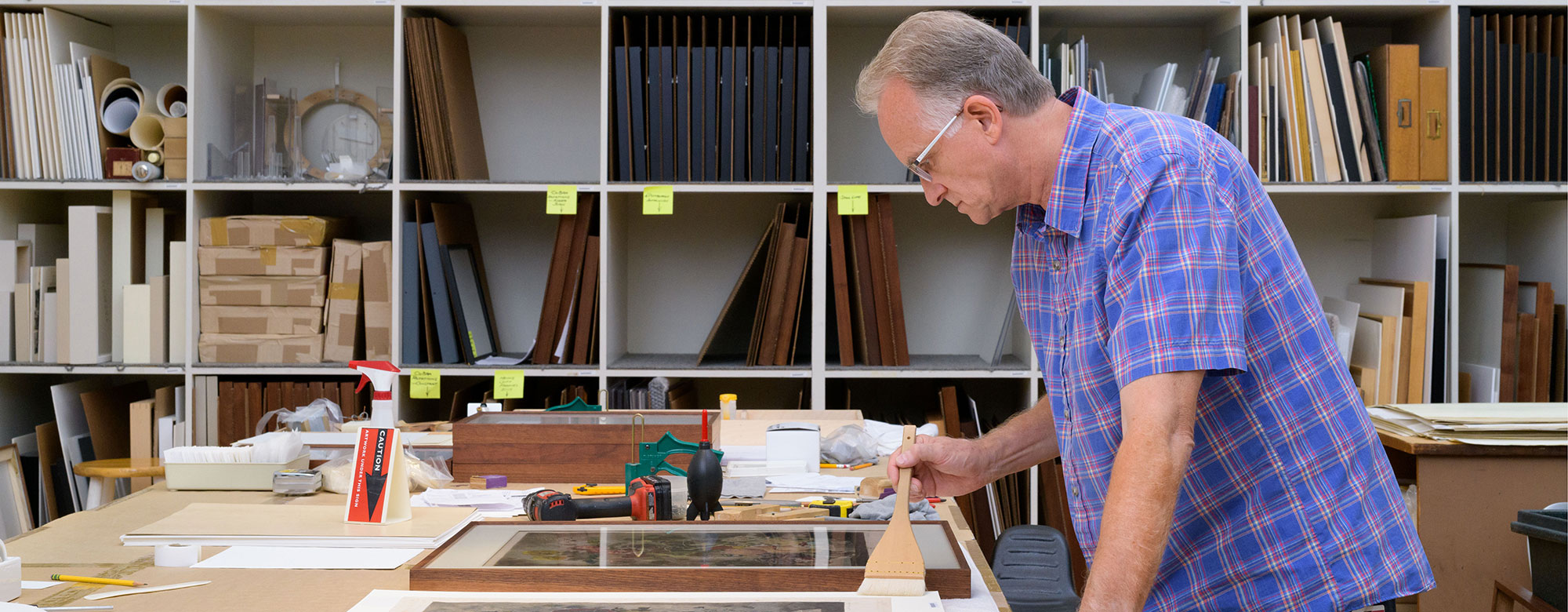You May Also Like
A Lifelong Love of Astronomy Closer Look: Walking the Land Restoring A ‘Palace of Music’A pair of stunning 18th-century prints rest, unprepared, on Dale Luce’s worktable. Located in Carnegie Museum of Art’s ground-floor matting room, it’s the spot where all matting and framing requests land for the museum’s extensive works on paper collection—thousands and thousands of prints, drawings, and photographs.
Luce, a museum preparator, carefully uses his bare hands to examine the hand-colored mezzotints depicting scenes overflowing with fresh flowers and fruit, destined for an upcoming Gallery One exhibition celebrating the humble genre of still life.
“Personally, I love older works,” Luce says as he evaluates the condition of the newly acquired prints. “Older paper quality—200 to 400 years old—is so good. When pasting on the back of it, you know how it will react, it’s predictable, and predictable is good.”
As the person who has matted and framed nearly every work on paper on view in the galleries over the last three decades (and then removed the frame for storage purposes), Luce knows his paper. Preparators forgo the use of disposable nitrile gloves when handling these light-sensitive treasures, he explains, because the physical touch tells them a lot about a material that has many variations—a paper’s weight, level of transparency, how absorbent it may be. “I’m at the point now where just by handling a piece, I know what will happen with it,” says Luce, who is also an artist and sculptor.
This knowing is key, as each object in the museum’s collection presents its own challenges when caring for it. While frame sizes at the museum have largely been standardized for cost and efficiency purposes, Luce regularly customizes mattes using acid-free board. To attach the works to the backing board, he uses the time-proven method of making Japanese tissue hinges. With wheat starch paste at the ready for adhesion, Luce shows an onlooker how the homemade papers are made out of fiber, making it vital to determine the direction of the grain first because it will determine the strength of the hinge.
Luce moves slowly and deliberately as he goes about his work in the museum’s matting room—a beautiful and functional workshop largely of his own making. A talented furniture maker, he built and installed the cabinets and repurposed the track lighting originally used in an installation from a past Carnegie International. It’s in this space that he’s also crafted from plexiglass hundreds of mounts used to display books of all kinds in the galleries. Because the mounts are designed to be both book and page specific—made to the exact shape of a particular opened book’s spine—they’re labor intensive. Especially because if one thing is certain in the museum world, Luce says with a laugh, it’s that “curators always change their mind.”
The rural New York state native who moved to Pittsburgh in 1975 to attend the former Ivy School of Professional Art on the North Side (where he hung out with fellow student and eventual art star Keith Haring) would certainly know. Counting his work on the upcoming still life exhibition, he’s contributed to an extraordinary 380 exhibitions, including eight Carnegie Internationals. Preparing for his August 2 retirement, when newly hired preparator Malia Dyson will take over his duties, Luce recalls the one time he matted, framed, installed, and de-installed a small show—including the mounting and removal of the wall labels—all by himself. For another installation, he and a small team framed 3,000 pieces of 8.5-by-11-inch type pages that they also had to keep in sequential order while hanging the work in a tile fashion from floor to ceiling.
Asked what he makes of his creative and lasting contributions, in his unassuming way, Luce says, simply, “It’s pretty cool.”
Receive more stories in your email
Sign upTags:
Behind the Scenes
